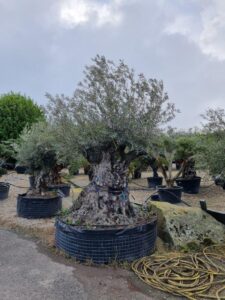
Fruit production: managing customer expectation
By Patrick Regnault
People like the idea of growing their own food, picking the fruits of their labour along the way, and juicing their own citrus every morning, fresh from the tree. If the picture in your head looks like advertising it is because it is as realistic as a commercial. The reality is very different and that is what we need to communicate to our clientele.
The amount of fruit a garden can supply depends on the number of trees, the choice of trees and species, their size, the aspect and the soil. Fruit tree numbers are proportional to the size of the garden. This seems obvious, but to many people it is not. Clients who have an urban or suburban background do not have the practical experience of food production and what it entails. They rely on what they can obtain from the supermarket or grocer and what they see and read in the media, which is very upbeat about the possibilities.

For fruit trees to produce and stay healthy, they need space. Cramming trees close together may seem like a good idea in the short term, but as the trees develop there will be mostly losers as the lack of airflow and competition for root space and nutrition will take a toll on the plants.
The small garden may be able to sustain one small fruit tree. This will depend on the amount of light the garden has and the tree will need to be self-pollinating. Espalier is a good way to grow fruit trees in limited space. Edible fig trees are prolific and fruit within two years and are well suited to being grown this way. Root systems of any trees in small gardens can cause structural damage and sometimes it is not appropriate to have anything but shrubs. Trees in pots have their limitations and a shortened lifespan. Caution is needed when considering dwarf varieties of fruit trees as although they are smaller, their size is relative to their full-size counterpart.
A medium garden can probably have three or maybe four fruit trees if it is large enough and not encumbered by structures. Three different fruit trees can produce for months if the choice is well thought out, satisfying the client and reminding them of the natural cycle of seasons.
A rural or semi-rural garden has more scope and can provide space for a small orchard. In this situation we may need to concentrate on ease of access, the suite of varieties and range of species.
Clients need us to give them appropriate, and long-term, advice. Providing them with a list of plants is not sufficient, we also need to give them a maintenance schedule that includes pruning, fertilising and general plant health. Advice we give has to be sound, based on practical experience, either direct or from qualified sources. We can, and need, to adapt our advice to suit the conditions and the demands but it has to be based, first and foremost, on plant health.
Fruit trees are productive after a varying amount of time depending on the genus. I have planted lemon trees that produced the following year, although I advised the client to forfeit the fruits to give the plant more chance to truly establish its structure to be able to successfully bear the fruit load in the future. In most cases it will take two to seven years for fruit trees to produce a reasonable number of fruits. Fruit trees provide more than their yield; they have an aesthetic quality, can provide shade, enhance biodiversity, and perfume an area. They will do so if they are given the space to naturally flourish.
As horticulturists we need to give appropriate advice, be very clear and put it in writing, grounding expectation through educating our clients. People may want trees that are unsuited to their area, and we need to be able to listen to their needs not their wants. We need to manage their expectations and come up with a plan that can give them satisfaction in the medium and long term. Food security is not resolved by planting your garden with edibles, but doing so helps people to understand the hazards faced in food production and the intricate interconnection of the natural world.
Patrick Regnault FAIH RH0062
Interactive Landscapes
